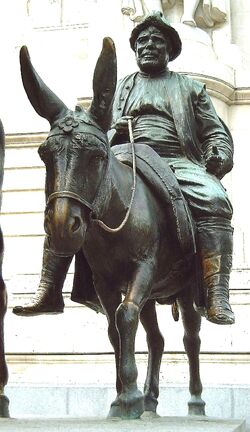| Sancho Panza | |
|---|---|
 | |
|
Real Name |
Sancho Panza |
|
First Appearance |
The Ingenious Gentleman Don Quixote of La Mancha (1605) |
|
Original Publisher |
Francisco de Robles |
|
Created by |
Miguel de Cervantes |
Origin[]
Before a fit of madness turned Alonso Quijano into Don Quixote, Sancho Panza was indeed his servant. When the novel beginsm Sancho has been married for a long time to a woman named Teresa Cascajo and has a daughter, Maria Sancha, who is said to be old enough to be married. Sancho's wife is described more or less as a feminine version of Sancho, both in looks and behaviour. When Don Quixote proposes Sancho to be his squire, neither he nor his family strongly oppose it.
Sancho is illiterate and proud of it but, by influence of his new master, he develops considerable knowledge about some books. Sancho instead provides the earthly wisdom of Spanish proverbs, surprising his master. During the travels with Don Quixote, he keeps contact with his wife by dictating letters addressed to her.
Sancho Panza offers interpolated narrative voice throughout the tale, a literary convention invented by Cervantes. Sancho Panza is a precursor to "the sidekick," and is symbolic of practicality over idealism. Sancho is the everyman, who, though not sharing his master's delusional "enchantment" until late in the novel, remains his ever-faithful companion realist, and functions as the clever sidekick. Salvador de Madariaga detected that, as the book progresses, there is a "Quixotization" of Sancho and a "Sanchification" of Don Quixote, so much that, when the knight recovers sanity on his deathbed, it is Sancho who tries to convince him to become pastoral shepherds.
In the novel, Don Quixote comments on the historical state and condition of Aragón and Castilla, which are vying for power in Europe. Sancho Panza represents, among other things, the quintessentially Spanish brand of skepticism of the period.
Sancho obediently follows his master, despite being sometimes puzzled by Quixote's actions. Riding a donkey, Rucio, he helps Quixote get out of various conflicts while looking forward to rewards of aventura that Quijote tells him of.
Cervantes variously names Sancho in the first book Sancho Zancas (legs); however, in the second book he standardizes Sancho's name in reply to the "false" Avellaneda Quixote sequel. At one point, Sancho alludes to the "false" Avellaneda book by addressing his wife (standardized as Teresa Panza) using the wrong name. The Sancho name does not change, but he calls his wife various names throughout the first part of the volume, and her 'true' name is not revealed until almost the end of that portion of the novel.
Don Quixote promises Sancho the governance of an ínsula, or island. However, Sancho has never heard of this word before, and does not know its meaning. Sancho has long been expecting some vague but concrete reward for this adventure, and believes the word to signify the prize that will make the trouble he has been enduring worthwhile.
The two later encounter a duke and duchess who pretend to make Sancho governor of a fictional fief, la ínsula Barataria (roughly "Isle Come-cheaply"; see Cockaigne). He eagerly accepts, and leaves his master. In a letter, Don Quixote gives Sancho provincial advice on governorship gleaned from the romances he has read, thought to have been inspired by the Diálogo de Mercurio y Carón attributed to Alfonso de Valdés. Quixote's simplistic and romantic understanding of government may have been the author using the allegorical ínsula to satirize the lack of practical learning on the part of philosopher-doctors' placed in positions of power.
The Duke's servants are instructed to play several pranks upon Sancho. Surprisingly, Sancho is able to rule justly (mostly), applying common (if occasionally inconsistent) sense and practical wisdom in spite of, or because of simplistic advice that Don Quixote has read about. As Sancho is abused in these staged parodies he learns how difficult it is to rule and "resigns" to rejoin Don Quixote and continue the adventure.
Sancho encounters Ricote ("fat cat"), his former Morisco neighbor, who has buried a small fortune. Ricote, like all Moriscos, was expelled from Spain and has returned in disguise to retrieve the treasure he left behind. He asks Sancho for his help. Sancho, while sympathetic, refuses to betray his king.
When Don Quixote takes to his deathbed, Sancho tries to cheer him. Sancho idealistically proposes they become pastoral shepherds and thus becomes 'Quixotized.'
Public Domain Appearances[]
Literature:
- The Ingenious Gentleman Don Quixote of La Mancha (1605) by Miguel de Cervantes
- The Ingenious Gentleman Don Quixote of La Mancha, Part 2 (1614) by Alonso Fernández de Avellaneda
- The Ingenious Gentleman Don Quixote of La Mancha, Part 2 (1615) by Miguel de Cervantes
- Vida de Don Quijote y Sancho (1914) by Miguel de Unamuno
Stage: The Comical History of Don Quixote (1694) by Thomas D'Urfey
- Vida do Grande Dom Quixote de la Mancha e do Gordo Sancho Pança (1733) by António José da Silva
- Don Quixote in England (1734) by Henry Fielding
- Don Quichotte chez la Duchesse (1743) by Joseph Bodin de Boismortier,
- Don Quichotte auf der Hochzeit des Camacho (1761) by Georg Philipp Telemann
- Don Quixote (1869) by Marius Petipa
- Don Quichotte (1874) by Victorien Sardou
- Don Quixote (1898) by Richard Strauss
- Don Quichotte (1912) by Jules Massenet
Film:
- Don Quixote (1906)
- Don Chisciotte (1911)
- Don Quixote (1915)